Page All: Viewing All Pages
Page 1
<B>Intro</B>:
<center> </center>
</center>
This week is the time for the second installment of <a href="http://www.sis.com">SiS</a>' chipsets. The 655TX is an evolution of the 655FX (which is why it came out after!), improving on the memory to CPU design to increase performance. We saw last week that the 655FX can hold its own against similar Intel chipsets, but how does the TX fair? Let's get into it shall we...?
<B>Box</B>:
Reference board! No box... (I throw this section in as a filler because I can )
)
<B>How it works</B>:
<center> </center>
</center>
From the above picture, you can see that the TX is pretty much the same as the FX in connectivity. It offers the basic features such as the AGP 3.5 Spec, Dual DDR (up to 4GB), and the latest 800MHz HT Pentium 4 CPUs... even Prescott. Where the TX gets its strength is the new memory controller that speeds up transactions by faking a command...
<center> </center>
</center>
By combing the above into a one step process, the TX can offer improved memory latency. Whether or not this will be any benefit will be shown in the benchmarks, but it is interesting to see how they increased the performance. Consider this a tweak to an already good chipset.
<B>The Board</B>:
<center> </center>
</center>
We won't dive into the board too much because it is a reference board after all. I'll be securing some retail products soon and will have reviews of the production boards on this and other chipsets. As you can see above, it is the 655TX in all its glory.
<center> </center>
</center>
You can see the weirdness of the board present in the reference boards. You'll note the connections on the bottom as well as buttons for power on and reset on the board itself. Also notice the placement of the ATX power connector and all the various capacitors on near the AGP/PCI slot region. You should also direct you attention to the CPU area, which is pretty clear of capacitors, except for on the left side. This one supports 4 DDR modules (1 GB max per slot).
<center> </center>
</center>
The ports on this one are the same as the other one. And also like the last one, the NIC didn't work. I don't know if it was just a bad batch or what, but when it was replaced with a PCI NIC it worked fine. Don't tell me I'm doing something wrong either, I do this stuff for a living. Let's move on to the meat of the review.
<B>Intro</B>:
<center>
 </center>
</center>This week is the time for the second installment of <a href="http://www.sis.com">SiS</a>' chipsets. The 655TX is an evolution of the 655FX (which is why it came out after!), improving on the memory to CPU design to increase performance. We saw last week that the 655FX can hold its own against similar Intel chipsets, but how does the TX fair? Let's get into it shall we...?
<B>Box</B>:
Reference board! No box... (I throw this section in as a filler because I can
 )
)<B>How it works</B>:
<center>
 </center>
</center>From the above picture, you can see that the TX is pretty much the same as the FX in connectivity. It offers the basic features such as the AGP 3.5 Spec, Dual DDR (up to 4GB), and the latest 800MHz HT Pentium 4 CPUs... even Prescott. Where the TX gets its strength is the new memory controller that speeds up transactions by faking a command...
<center>
 </center>
</center>By combing the above into a one step process, the TX can offer improved memory latency. Whether or not this will be any benefit will be shown in the benchmarks, but it is interesting to see how they increased the performance. Consider this a tweak to an already good chipset.
<B>The Board</B>:
<center>
 </center>
</center>We won't dive into the board too much because it is a reference board after all. I'll be securing some retail products soon and will have reviews of the production boards on this and other chipsets. As you can see above, it is the 655TX in all its glory.
<center>
 </center>
</center>You can see the weirdness of the board present in the reference boards. You'll note the connections on the bottom as well as buttons for power on and reset on the board itself. Also notice the placement of the ATX power connector and all the various capacitors on near the AGP/PCI slot region. You should also direct you attention to the CPU area, which is pretty clear of capacitors, except for on the left side. This one supports 4 DDR modules (1 GB max per slot).
<center>
 </center>
</center>The ports on this one are the same as the other one. And also like the last one, the NIC didn't work. I don't know if it was just a bad batch or what, but when it was replaced with a PCI NIC it worked fine. Don't tell me I'm doing something wrong either, I do this stuff for a living. Let's move on to the meat of the review.
Page 2
<B>The testing systems</B>:
I used all similar components except for the motherboard to keep the testing controlled.
Standard components:
TwinMOS PC4000 2x256MB DDR (Running at stock) (Review coming soon)
120GB Maxtor 8MB HDD
Pentium 4 CPU 2.4 800MHz
Leadtek GF FX 5600 Det 53.03
HP DVD 100i
Win2k SP4 with all hotfixes and recommended updates.
Running the latest Chipset drivers for all three chipsets.
All benchmarks were run at the lowest detail setting on 640x480 except where noted. Blue denotes the 655TX while the dark gray denotes the 655FX and the light gray denotes an Intel Springdale chipset board (Gigabyte 8IPE Pro 2).
<B>Benchmarks</B>:
<center>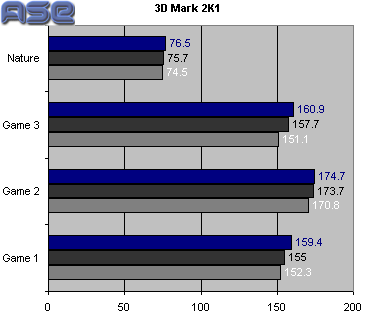 </center>
</center>
First up is 3D Mark 2K1 SE. This I'll probably use for some time as it is a good test of the CPU/Memory/AGP subsystem (The Northbridge!). As you can see, the TX is slightly faster than the FX, and faster compared to the Springdale alone.
<center>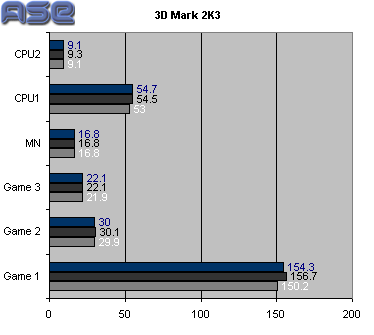 </center>
</center>
The 03 Version of 3DMark paints a different picture. The two chipsets are pretty much even in this one.
<center>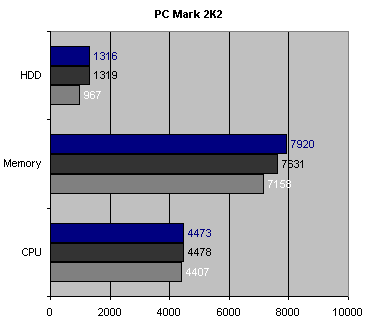 </center>
</center>
In PC Mark, we see the improved memory subsystem in action.
<center>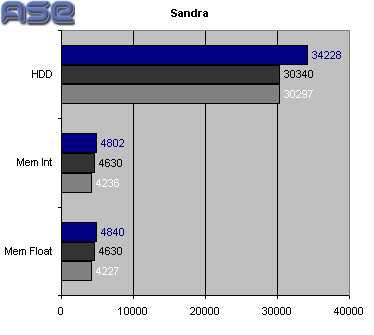 </center>
</center>
Sandra also shows us this fact. And look at the extra IDE speed as well. Don't know what that's about. I tested it over and over and came up with the same result.
<center>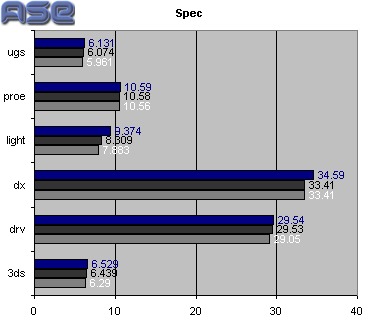 </center>
</center>
Spec scores are also very slightly faster than the FX. The updated chipset is doing well.
<center>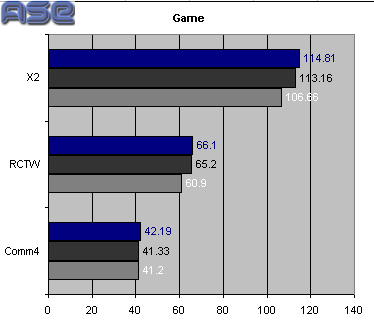 </center>
</center>
And in the real games, we can see the added memory speed helps a bit... very slightly, but noticeable.
All in all, SiS has made the TX a worthy successor to the FX.
<B>The testing systems</B>:
I used all similar components except for the motherboard to keep the testing controlled.
Standard components:
TwinMOS PC4000 2x256MB DDR (Running at stock) (Review coming soon)
120GB Maxtor 8MB HDD
Pentium 4 CPU 2.4 800MHz
Leadtek GF FX 5600 Det 53.03
HP DVD 100i
Win2k SP4 with all hotfixes and recommended updates.
Running the latest Chipset drivers for all three chipsets.
All benchmarks were run at the lowest detail setting on 640x480 except where noted. Blue denotes the 655TX while the dark gray denotes the 655FX and the light gray denotes an Intel Springdale chipset board (Gigabyte 8IPE Pro 2).
<B>Benchmarks</B>:
<center>
 </center>
</center>First up is 3D Mark 2K1 SE. This I'll probably use for some time as it is a good test of the CPU/Memory/AGP subsystem (The Northbridge!). As you can see, the TX is slightly faster than the FX, and faster compared to the Springdale alone.
<center>
 </center>
</center>The 03 Version of 3DMark paints a different picture. The two chipsets are pretty much even in this one.
<center>
 </center>
</center>In PC Mark, we see the improved memory subsystem in action.
<center>
 </center>
</center>Sandra also shows us this fact. And look at the extra IDE speed as well. Don't know what that's about. I tested it over and over and came up with the same result.
<center>
 </center>
</center>Spec scores are also very slightly faster than the FX. The updated chipset is doing well.
<center>
 </center>
</center>And in the real games, we can see the added memory speed helps a bit... very slightly, but noticeable.
All in all, SiS has made the TX a worthy successor to the FX.
Page 3
<B>Overclocking</B>:
We'll wait till some retails boards for this...
<B>Conclusion</B>:
Without a doubt, this is one tough chipset. It is a very strong competitor to the Springdale/Canterwood fame of Intel and does it well. It posts very high numbers with its new memory trick. <a href="http://ase.dealtime.com/dt-app/SE/KW-sis 655tx/FD-0/linkin_id-3002062/NS-1/GS.html">You can buy boards based on the TX right now</a>. I recommend the Asus one of course. If you thought the FX was good, this is even better. Buy this one instead!
I'd like to thank Ginno from <a href="http://www.sis.com">SiS</a> for sending both boards for review.
<B>Overclocking</B>:
We'll wait till some retails boards for this...
<B>Conclusion</B>:
Without a doubt, this is one tough chipset. It is a very strong competitor to the Springdale/Canterwood fame of Intel and does it well. It posts very high numbers with its new memory trick. <a href="http://ase.dealtime.com/dt-app/SE/KW-sis 655tx/FD-0/linkin_id-3002062/NS-1/GS.html">You can buy boards based on the TX right now</a>. I recommend the Asus one of course. If you thought the FX was good, this is even better. Buy this one instead!
I'd like to thank Ginno from <a href="http://www.sis.com">SiS</a> for sending both boards for review.
